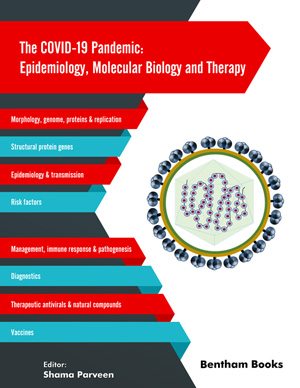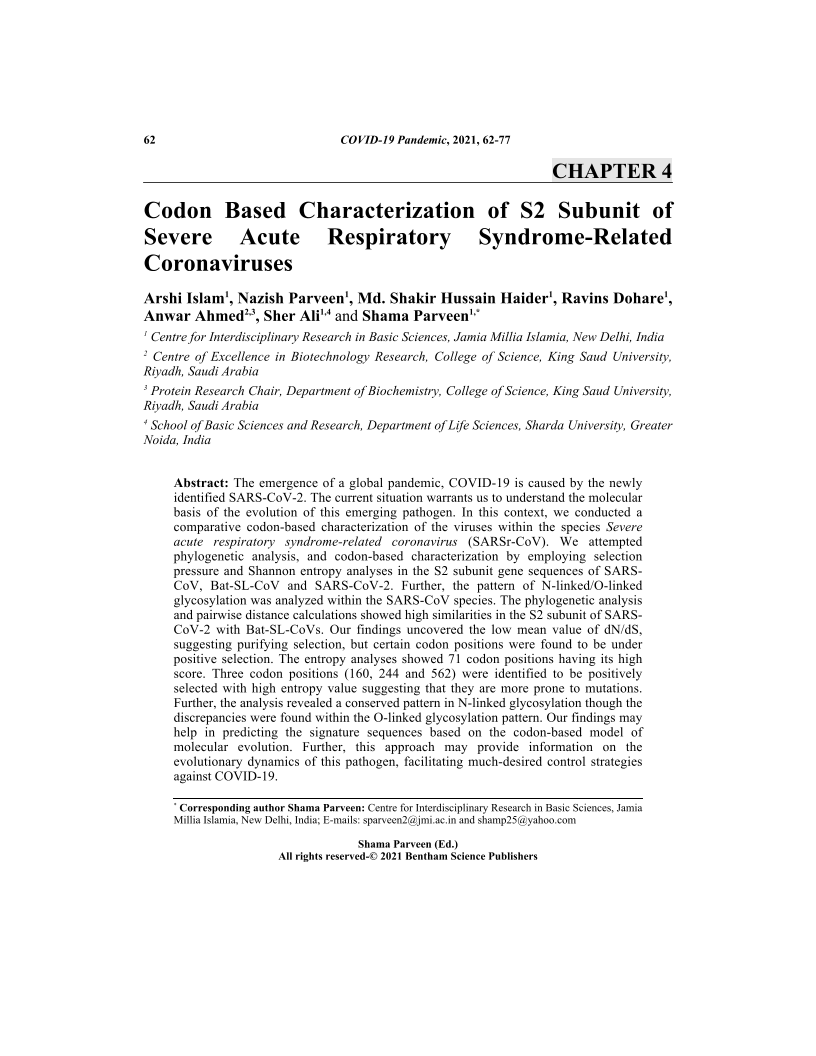Codon Based Characterization of S2 Subunit of Severe Acute Respiratory Syndrome-Related Coronaviruses

- Authors: Arshi Islam1, Nazish Parveen2, Md. Shakir Hussain Haider3, Ravins Dohare4, Anwar Ahmed5, Sher Ali6, Shama Parveen7
-
View Affiliations Hide Affiliations1 "Centre for Interdisciplinary Research in Basic Sciences, Jamia Millia Islamia, New Delhi, India 2 "Centre for Interdisciplinary Research in Basic Sciences, Jamia Millia Islamia, New Delhi, India 3 "Centre for Interdisciplinary Research in Basic Sciences, Jamia Millia Islamia, New Delhi, India 4 "Centre for Interdisciplinary Research in Basic Sciences, Jamia Millia Islamia, New Delhi, India 5 "Center of Excellence in Biotechnology Research, College of Science, King Saud University, Riyadh, , Saudi Arabia 6 "School of Basic Sciences and Research, Department of Life Sciences, Sharda University, Greater Noida, India 7 Centre for Interdisciplinary Research in Basic Sciences, Jamia Millia Islamia, New Delhi, India
- Source: The COVID-19 Pandemic: Epidemiology, Molecular Biology and Therapy , pp 62-77
- Publication Date: February 2021
- Language: English
Codon Based Characterization of S2 Subunit of Severe Acute Respiratory Syndrome-Related Coronaviruses, Page 1 of 1
< Previous page | Next page > /docserver/preview/fulltext/9789811481871/chapter-4-1.gif
The emergence of a global pandemic, COVID-19 is caused by the newly identified SARS-CoV-2. The current situation warrants us to understand the molecular basis of the evolution of this emerging pathogen. In this context, we conducted a comparative codon-based characterization of the viruses within the species Severe acute respiratory syndrome-related coronavirus (SARSr-CoV). We attempted phylogenetic analysis, and codon-based characterization by employing selection pressure and Shannon entropy analyses in the S2 subunit gene sequences of SARSCoV, Bat-SL-CoV and SARS-CoV-2. Further, the pattern of N-linked/O-linked glycosylation was analyzed within the SARS-CoV species. The phylogenetic analysis and pairwise distance calculations showed high similarities in the S2 subunit of SARSCoV- 2 with Bat-SL-CoVs. Our findings uncovered the low mean value of dN/dS, suggesting purifying selection, but certain codon positions were found to be under positive selection. The entropy analyses showed 71 codon positions having its high score. Three codon positions (160, 244 and 562) were identified to be positively selected with high entropy value suggesting that they are more prone to mutations. Further, the analysis revealed a conserved pattern in N-linked glycosylation though the discrepancies were found within the O-linked glycosylation pattern. Our findings may help in predicting the signature sequences based on the codon-based model of molecular evolution. Further, this approach may provide information on the evolutionary dynamics of this pathogen, facilitating much-desired control strategies against COVID-19.
-
From This Site
/content/books/9789811481871.chapter-4dcterms_subject,pub_keyword-contentType:Journal -contentType:Figure -contentType:Table -contentType:SupplementaryData105

